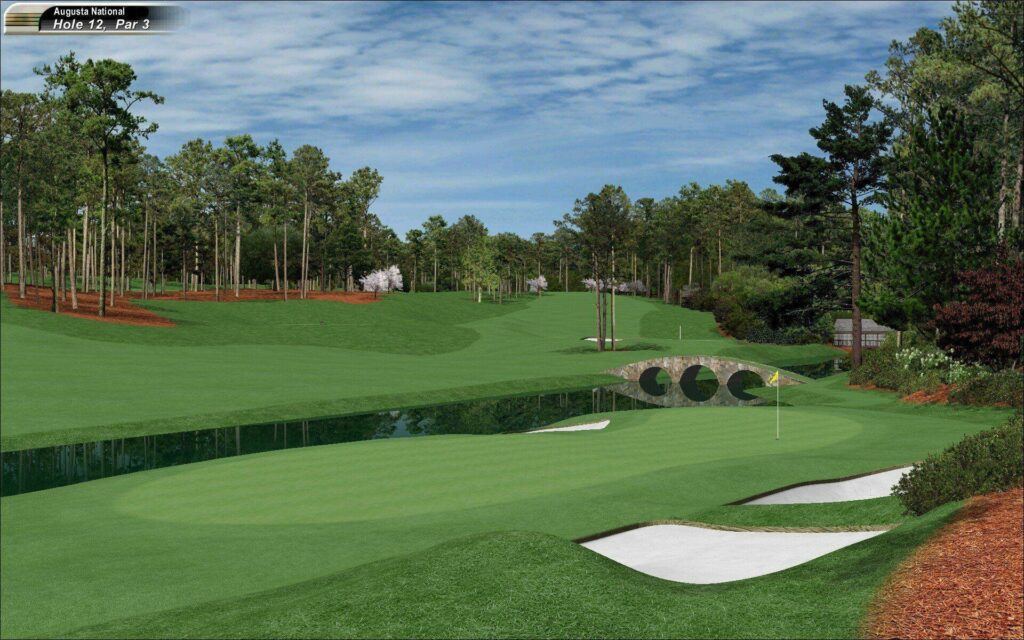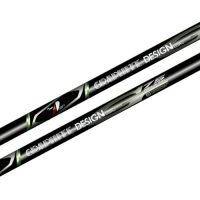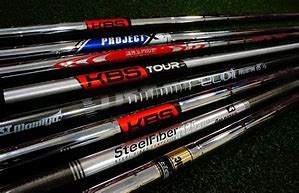Golf Club Shafts
If you need to change your golf club shafts or are looking to upgrade, there is a huge selection of steel and graphite golf club shafts to choose from. You can select from all the major golf club shaft brands available. Whether you are a novice, intermediate, or advanced golfer, the shaft is among the most important equipment choices you can make. A golf shaft not only determines how a club feels during your golf swing but how it performs in a wide range of scenarios. Replacing the shaft on your golf clubs can be affordable and easy! Explore an array of golf club shafts at the lowest prices guaranteed. Get golf club shafts to fit your swing. Select your club shaft and start playing better golf today!

Steel vs. Graphite Shafts
Steel Golf Club Shafts
Golf club shafts made with steel are stronger, more durable, and generally less expensive than graphite. They are made from carbon steel, although stainless steel is sometimes used.
Steel shafts do not experience the torque or lateral twisting found in all graphite shafts. Therefore, most players would benefit from having steel shafts in their irons. They offer more control over shots and have a greater emphasis on accuracy over distance than graphite shafts. Also, steel shafts require a faster swing speed to generate the same distance as a graphite shaft. Consequently, steel shafts are recommended for players with normal swing speeds who could use a little extra control in their game.
Stepped Steel Shafts
Stepped steel shafts are used to gradually reduce the diameter of the shaft from the wider butt end to the narrower tip.A steel strip is rolled into a tube and then mechanically drawn until the diameter and thickness are correct. The step pattern is then formed, and the walls are made thinner at the tip and thicker at the top. This produces flexibility or kick points. The shaft is then hardened, straightened, and finally chrome-plated. In addition, this advanced manufacturing process offers consistency from shaft to shaft. It also gives the same stiffness throughout an entire set. Stepped steel shafts are used in the majority of golf clubs by all the major manufacturers.
Rifle Steel Shafts
The main difference with Rifle shafts is that the steel is smooth from top to bottom and has no steps. Rifle offers unlimited customization options for clubmakers to fine-tune the spin and launch angle to the exact DNA of a golfer’s game. Further, Rifle perfectly blends tip responsiveness and tip stability for enhanced control. The rifle’s frequency-matching design ensures tighter specs and tolerance for a consistent flex progression throughout the set.
Shaft Consistency
Rifle shafts are one of the most consistently performing shafts on the market from one club to the next within a set of irons or woods. Shaft design and construction use different technologies to provide greater performance. Also, the Frequency Matching of each shaft perfectly matches the flex throughout a set of clubs using electronic calibration. Flexes in Rifle shafts can also be more specifically tailored for the average golfer as they use decimals to measure stiffness (e.g. 5.0, 5.5, 6.0, etc.). Furthermore, the step-less design technology eliminates the energy-robbing steps found on most other steel shafts. Rifle manufacturers claim this provides greater accuracy. Additionally, some Rifle shafts offer ‘flighted’ versions that can produce variable ball trajectories for different clubs within a single set.
Select your new irons with the correct club shaft and start playing better golf today! Click on the direct link and go here ⇓ https://www.tkqlhce.com/click-8400904-15438720.
Graphite Golf Club Shafts
Generally speaking, graphite golf club shafts are more expensive than steel and less durable. The lighter weight provides greater swing speed for more power. However, it sacrifices control due to the flex generated during the swing.
Variations and Weight
The variation in flexes (and colors) makes graphite shafts a very popular choice with professionals and amateurs alike. They are also suited to lady golfers and older players who cannot produce the swing speed to use a steel shaft effectively. In addition, the shaft is produced using Graphite tape with an epoxy binder wrapped around a steel mandrel. The shaft is then heated and the mandrel is removed. After it has cooled, the shaft is sanded and cut. It is then painted. Graphite golf club shafts can reduce the weight of your club. You can notice the difference if you’ve used steel shafts before.
Weight Of the Golf Shaft

They weigh between 50-85 grams, while their steel counterparts generally start at 120 grams. Graphite shafts also dampen shaft vibrations better than steel, which is why several high-profile injured golf pros recovering from surgery use them to recover. On the downside, it is more difficult than steel to get a consistent feel and stiffness in a set of graphite shafted irons.
Graphite shafts are great for getting greater distances from today’s oversized titanium drivers. They allow shafts to be longer. But remember, longer clubs are good for distance, not for control. Graphite is lighter than steel and can be made in many variations. Thus, making it easier to select a shaft best suited to your game.
Maintenance of Your Golf Shafts
In short, the major negative of graphite shafts is that they need to be looked after more than steel shafts. Make sure you have extra-long headcovers on woods or padded dividers in your golf bag. This is important so that the paint on the graphite shaft does not get worn off. In short, this can negatively affect the performance of the shaft.
Multi-Material Shafts
A recent addition to the shaft market is the multi-material shaft. Used on both irons and drivers, this shaft combines both steel and graphite into one shaft to try and get the best of both worlds.
Typically, it is mainly a steel shaft that has a graphite tip. The steel section of the shaft offers a solid shaft that allows players to control the ball’s flight more. The graphite tip also lets the driver have a limited amount of ‘whip’ into the ball, which can help produce more distance. Additionally, the graphite tip helps filter out any unwanted vibrations at contact to optimize the feel of each shot.
Titanium Golf Club Shafts
Titanium golf club shafts are a relatively new material in shafts. Currently, there is not much information available about the manufacturing process. The shaft itself is lightweight (titanium being lighter than steel). It can dampen vibrations.
Titanium shafts have great strength. They are also on the stiff side. This is good for stronger golfers who have no trouble getting distance on their shots but may be concerned with accuracy. The stiffer shafts will keep the ball from straying off course, as long as your aim is good. Furthermore, golfers will get power from being able to generate the titanium shafts with enough speed and then snapping their right hand at impact. The key to being able to use the titanium shafts successfully is having enough strength to swing the clubs.
Nanofuse Shafts
Nanofuse shafts are not steel, but they are metallic. They’re not graphite, but they are firmly rooted in carbon fiber.They are created by fusing a nanocrystalline alloy with a carbon fiber composite polymer sublayer. The manufacturers also claim this gives you a shaft with the consistency of steel and distance and feel benefits of graphite. The key lies in an unimaginably small and tight grain structure in the NanoFuse material. This increases strength dramatically which helps with accuracy.
Golf Club Shaft Technology
What Is Shaft Flex?
Flex is the most important factor in the shaft as it affects distance and direction. Getting the correct flex in your golf equipment is of the utmost importance. The flex is a rating of a golf club shaft’s ability to bend during the golf swing. Furthermore, all shafts, no matter how stiff, exhibit flex under the forces of the golf swing. A player with a very fast swing will require a shaft with less flex. A player with a slower swing will need a shaft with greater flexibility.
Seven Types of Shaft Flex
Listed Below Are the Seven Golf Shaft Flexes:
- Extra Stiff (XS)
- Stiff (S)
- Firm (F)
- Regular (R)
- Senior (S)
- Amateur (A)
- Ladies (L)

The less the bend in the shaft, the more control a powerful swinger will have. On the other hand, beginners and those with less powerful swings generally use a shaft with greater flexibility. The average swing speed with a driver is from 65 miles per hour for a beginner up to over 100 miles per hour for powerful swingers.
Differences in Specifications:
Many shaft manufacturers have differences in their specifications of flex. One manufacturer’s regular flex might be another’s firm flex. There are 2 methods of measuring flex. They are the more traditional Shaft Deflection Board and the modern Frequency Analyzer. Also, both are effective in the measurement of flex. Stiffness defines the bending characteristics of the shaft when weight is applied. Frequency is another way of defining stiffness. Further, it indicates how fast a club will vibrate with that particular shaft. The stiffer the shaft, the faster the vibration. If you have a low swing speed, more flexible shafts will propel the ball more at the downswing. If you have a high swing speed, a stiffer shaft avoids lagging club heads.
Golf Club Shafts – What Is Shaft Torque?
Torque is the twisting movement of the shaft during the golf swing. It is measured in degrees and shown as a rating that gives information about the ‘twisting’ characteristics. The higher the rating, the more the shaft twists and vice versa. The more torque a shaft has, the softer it will feel. In addition, a shaft with a 3-degree torque will feel much stiffer than one that has a 5-degree torque. Every shaft, graphite or steel, has a certain amount of torque. Also, most steel shafts have up to about 3 degrees of torque. Torque, however, has a slight effect on ball trajectory, the lower the torque, the lower the trajectory.
What Is a Shaft Kick-Point (Flex-Point)?
This defines the point where the shaft bends and affects the trajectory of the shot. The effect is small but measurable. A shaft with a high kick-point will usually give a low shot trajectory and more of a “one-piece” feel to the shaft. Also, a low kick-point will usually give a high shot trajectory and a feeling of the shaft tip whipping the clubhead through.
Kick-point will also affect the feel of the shaft. Some club specialists will dispute this by saying that the Kick-point and bend-point are the same. Further, the bend-point is the highest point of the shaft when it is bending by applying pressure to both ends of the shaft. In addition, the Kick-point is the highest point the shaft is bending. This is accomplished by clamping down on the grip while pressure is applied onto the club’s head, as in the swing. There will be some shafts where both bending points are similar and very close.
Weight Of a Shaft?
The weight is the actual weight of the raw, uncut shaft before installation, in grams. Also, lighter shafts mean lighter total weight. This permits the prospect of additional clubhead speed and greater distance.
Alignment of a Shaft?
Have you noticed that sometimes you will have a favorite club in a set of clubs that you just seem to hit better and more consistently than the others? This is most likely because the spine of the club happens by chance to be correctly aligned with the club. The opposite is probably true for the club in a set that you can’t seem to hit well at all!
Did You Know Most Golf Shafts Have Some Sort of Minor Irregularity in Them That Is Inherent in the Manufacturing Process?
This Can Occur From:
- the join of the shaft,
- The shaft is not perfectly round.
- the material of the shaft may be just slightly heavier on one side of the shaft than the other,
- or from an imperfection in the shaft material. This can cause the shaft to bend towards a certain point when you swing, causing the clubface to open or close.

Ok, I sure do wish I had found this article before looking for clubs. Although, I have not purchased yet. From what I read here, being a lady, left handed, and more of a novice, the steel shaft is going to benefit me more than the graphite. Am I right in this assumption? If I do go with steel shafts, could these possibly last me a long time before I will want to switch to graphite shafts?
Graphite shafts are better than steel because they are lighter and easier to swing. However, today most irons have steel shafts and woods and hybrids have graphite. But it is good to have graphite in your shafts for your irons. Look for a ladies, left handed complete set that has all graphite. You will benefit the most by them. Both steel and graphite are very durable shafts. Don’t store your clubs in the trunk of your car overnight etc. Bring them into the house and where it is dry and not subject to the weather. Yes, graphite costs more than steel shafts but are worth the investment. This is especially true for ladies and seniors.
Hi there, great detailed information.
While it is wonderful to find articles like this to learn about equipment choices, it can certainly be confusing for nubies. For example, I’m wondering at what point one should start worrying about shaft materials. Knowing experience can’t be improvised, is there a way of discovering early on what would be the best fit for me?
Or, would it be a matter of trying different options over time to see how they affect performance?
Based on the info you have provided I’m thinking rifle steel shafts would be an ideal starting point for a fairly strong male; would you agree?
Thanks!
Edwin, Thanks for the comments. Rifle shafts are an excellent shaft for your irons. Personally, I recommend graphite shafts for your woods and hybrids.
The new Rifle shaft offers unlimited customization options. Rifle perfectly blends tip responsiveness and tip
stability for enhanced control. Rifle’s frequency matched design ensures tighter specs and tolerances for consistent flex progression throughout your set.
Rifle shafts are available in parallel and now tapered tip
options for more customization opportunities. Rifle is available
exclusively through Performance Fitting Centers. You should contact a club fitter in your
area for the best custom fitting experience with Rifle. Depending on your swing speed either a Regular or Stiff rifle shaft should help your game.